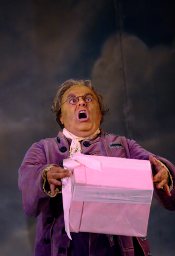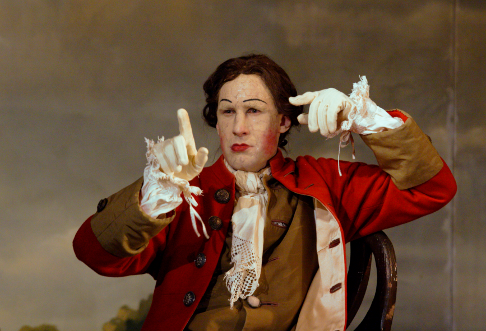15 Sep 2010
Don Pasquale at the Royal Opera House
This show, a revival of Jonathan Miller’s 2004 production (first seen at the Maggio Musicale in Florence) is certainly a feast for the eyes.

This show, a revival of Jonathan Miller’s 2004 production (first seen at the Maggio Musicale in Florence) is certainly a feast for the eyes.
Isabella Bywater beautifully realises Miller’s clever visual concept, presenting us with an exquisite reproduction of an eighteenth-century doll’s house, the façade of which is drawn back to reveal a realistic and immensely detailed interior — the connecting corridors, doors and stairwells are perfect for upstairs-downstairs intrigues and affairs. Bywater is alert to every minor detail, the only anachronism being the arrival of boxes from Versace, Prada, Escada and La Perla after Norina’s extravagant post-marriage spending spree. Costumes are similarly precise and elaborate, the characters dressed as elaborate mannequins, with whitened faces, and gowns and cloaks of gharish reds, purples and pinks.
Beyond its visual appeal, this set has one clear advantage: it can be seen clearly from all corners and heights of the auditorium — not something that could be boasted off all recent ROH productions. However, enclosing the action in a succession of tiny chambers, three-storeys high, does produce a rather ‘distanced’ result, and at times the singers, trapped in their cubicles, struggled to project over the orchestral fabric and to communicate directly with the audience. It is thus quite a relief when, in the closing moments, the protagonists venture into the garden; as the door of the doll’s house is closed, a reassuring air of reality is intimately; these are real characters after all, not puppets, although the artificial world is still visible through a narrow chink, and the genuinely tragic and comic sentiments of this human drama are never fully evoked.
 Paolo Gavanelli as Don Pasquale
Paolo Gavanelli as Don Pasquale
As the eponymous old ogler, duped by his avaricious nephew, Paolo Gavanelli
huffed and puffed, stamped and pounded, frustrated and exasperated almost to
the point of self-combustion. While he hammed up the gags, Gavanelli’s
baritone is a little heavy and his portrayal would have benefitted from some
light buffo esprit — and from crisper diction. His patter-duet
with Dr Malatesta, sung by Jacques Imbrailo, is the high point of the comedy,
but it did not produce quite the excitement that it should, and was the wrong
sort of ‘breathless’.
Imbrailo was a confident, wry Malatesta — a Dulcimara with style. Among the two-dimensional stereotypes, he conveyed a naturalism and credibility, sang with clear diction, and balanced lyricism with dramatic singing. A recent graduate of the Jette Parker Young Artist scheme, he’s one to watch.
Barry Banks, as Ernesto, was reportedly afflicted with an allergic reaction; his high, ringing tenor was a little unyielding at times, but, while he did not attain a truly Italianate bel canto lyricism, his voice has a freshness and focus which added vigour to a foppish role.
Making her house debut, Íride Martínez initially appeared somewhat nervous. This Norina was rather shrill and uncomfortable, but Martínez relaxed as the evening progressed and had no difficulty spanning the vocal compass of the role, or dispatching the coloratura demands of the final act. She revealed a sure sense of comic timing and gradually began to enjoy herself, metamorphosing from sweet young bride to scathing harridan.
 Jacques Imbrailo as Doctor Malatesta
Jacques Imbrailo as Doctor Malatesta
The chorus have little to do musically until Act 3, but they kept themselves busy, dusting, cooking, gossiping…at times all this activity was a little distracting. When they did get the opportunity to sing, however, they produced an exciting, invigorated ensemble sound.
Perhaps sensing that the cast were rather constricted by the staging, Evelino Pidò injected some movement and fizz in the pit; tempi were pacy, textures were clear — there was some exquisite woodwind playing — and the accompanying patterns were energetic and light-footed.
Overall, the performances were solid but for this listener the parts did not add up to a totally convincing whole. Most unsettling of all, in this production the values articulated by this fairly straightforward farce were not absolutely clear - who are the ‘baddies’? We may pity our ‘hero’, Ernesto, as a lover deprived of his heart’s desire; but his campness is less appealing and his covetousness less admirable. Norina is an amusing minx but the slap she delivers to her long-suffering husband, sits uncomfortably among the frivolities and artifice, and dilutes our sympathy. Don Pasquale is a pitiful dupe, but also a dissipated old lecher. Even the calculating Malatesta is an ambiguous ‘villain’: his intentions are, after all, beneficent, and his manipulative scheming does have a happy outcome.
One can’t help feeling that things should either be more frothy or more revelatory. As it is, it’s hard to care about these marionettes in their artificial bubble.
Claire Seymour